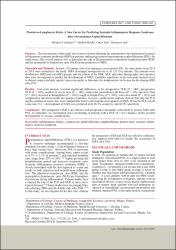| dc.contributor.author | Çetinkaya, Mehmet | |
| dc.contributor.author | Buldu, İbrahim | |
| dc.contributor.author | Kurt, Ömer | |
| dc.contributor.author | İnan, Ramazan | |
| dc.date.accessioned | 2020-11-20T14:51:56Z | |
| dc.date.available | 2020-11-20T14:51:56Z | |
| dc.date.issued | 2017 | |
| dc.identifier.issn | 1735-1308 | |
| dc.identifier.issn | 1735-546X | |
| dc.identifier.uri | https://hdl.handle.net/20.500.12809/1831 | |
| dc.description | WOS: 000418781000003 | en_US |
| dc.description | PubMed ID: 28853103 | en_US |
| dc.description.abstract | Purpose: The first purpose of this study was to reveal factors affecting the postoperative development of systemic inflammatory response syndrome (SIRS) in patients undergoing standard percutaneous nephrolithotomy (PNL) for renal stones. The second purpose was to determine the role of the preoperative platelet-to-lymphocyte ratio (PLR) and the neutrophil-to-lymphocyte ratio (NLR) in the prediction of SIRS. Matarials and Methods: In total, 192 patients who had undergone conventional PNL for renal stones from 2013 to 2015 were included in the study. SIRS developed postoperatively in 41 (21.3%) patients. The patients were divided into SIRS and non-SIRS groups, and the effects of the PLR, NLR, and other demographic and operative data were investigated to predict the development of SIRS. Variables significant in the univariate analysis were evaluated using a multiple logistic regression model to determine the independent risk factors for developing SIRS after PNL. Results: Univariate analysis revealed significant differences in the preoperative PLR (P < .001), preoperative NLR (P = .018), number of access sites (P < .001), mean renal parenchymal thickness (P = .02), operative time (P < .001), decrease in hemoglobin (P = .016), length of hospital stay (P < .001), stone-free status (P = .023), and complication rate between the two groups of patients. However, multivariate analysis showed that only the PLR and the number of access sites were independent factors affecting the development of SIRS. When the PLR cut-off value was 114.1, development of SIRS was predicted with 80.4% sensitivity and 60.2% specificity. Conclusion: The preoperative PLR is an effective and inexpensive biomarker with which to predict SIRS after PNL. In particular, we recommend close monitoring of patients with a PLR of >114.1 because of the possible development of serious complications. | en_US |
| dc.item-language.iso | eng | en_US |
| dc.publisher | Urol & Nephrol Res Ctr-Unrc | en_US |
| dc.item-rights | info:eu-repo/semantics/openAccess | en_US |
| dc.subject | Inflammation | en_US |
| dc.subject | Kidney | en_US |
| dc.subject | Lymphocyte | en_US |
| dc.subject | Nephrolithotomy | en_US |
| dc.subject | Nephrolithiasis | en_US |
| dc.subject | Platelet Ratio | en_US |
| dc.subject | Systemic Inflammatory Response Syndrome | en_US |
| dc.title | Platelet-to-Lymphocyte Ratio: A New Factor for Predicting Systemic Inflammatory Response Syndrome after Percutaneous Nephrolithotomy | en_US |
| dc.item-type | article | en_US |
| dc.contributor.department | MÜ, Tıp Fakültesi, Cerrahi Tıp Bilimleri Bölümü | en_US |
| dc.contributor.institutionauthor | Çetinkaya, Mehmet | |
| dc.identifier.volume | 14 | en_US |
| dc.identifier.issue | 5 | en_US |
| dc.identifier.startpage | 4089 | en_US |
| dc.identifier.endpage | 4093 | en_US |
| dc.relation.journal | Urology Journal | en_US |
| dc.relation.publicationcategory | Makale - Uluslararası Hakemli Dergi - Kurum Öğretim Elemanı | en_US |


















